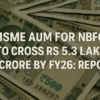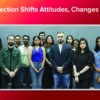
India’s NBFC sector has turned out to be the most dynamic sector helping to fill the credit gap with its wide variety of products and serving even the most underserved customers in the remotest regions. What NBFCs have done for the country in 5 years would have easily taken 15-20 years in their absence. That is what encouraged Banking Frontiers to organize an awards-cum-conference-exhibition focused purely on the NBFC sector. We present here the highlights of 3 panel discussions. All views expressed here are the personal views of the panelists and do not necessarily reflect the views of their respective organizations:
Part 1:
CEO Panel Discussion: Supply Chain Finance &
Customer Acquisition Cost
CEOs of numerous NBFCs come together on the dais to discuss the growth opportunities and the corresponding gateways and barriers:
Panelists:
- Vikrant Narang, Deputy CEO, Ambit Finvest
- Deepak Jain, Co-Founder, Flexiloans
- Sukesh Bhowal, CEO, Motilal Oswal Home Finance
- Jugal Mantri, Executive Director & CEO, Anand Rathi Global Finance
- Purvi Bhavsar, MD, Pahal Financial Services
- Rakesh Kumar, CEO, Light
- Sankar Sastri, Jt CEO, APAC Financial Services
- Shantanu Rege, MD & CEO, Mahindra Home Finance
- Moderator: Manoj Agrawal, Group Editor, Banking Frontiers
Manoj Agrawal: A lot of global changes are unpredictable, whether it’s war or global warming or floods or geopolitics. This has disrupted many supply chains. Consequentially, many new opportunities have emerged when it comes to supply chains, and India is trying to grab that opportunity. Which are the supply chains that you think India should focus upon?
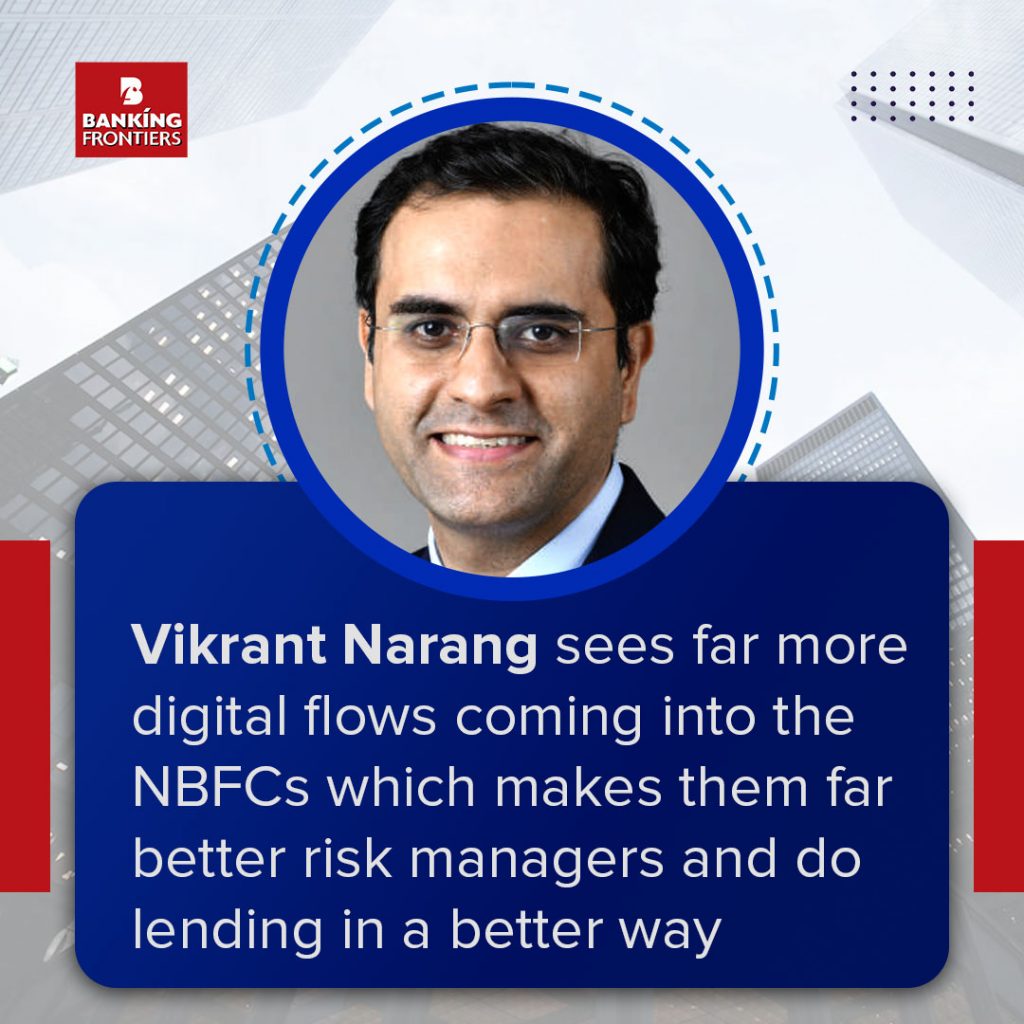 Vikrant Narang: NBFCs now are around 25-30% of the total credit which gets disbursed, and so we are pretty relevant sector. There are many changes happening in the global markets, but our own domestic economy is still in a very benign phase and each one of us is seeing a very strong growth trajectory.
Vikrant Narang: NBFCs now are around 25-30% of the total credit which gets disbursed, and so we are pretty relevant sector. There are many changes happening in the global markets, but our own domestic economy is still in a very benign phase and each one of us is seeing a very strong growth trajectory.
Also, there is no significant increase in risk from a lending standpointt. While there is growth, people are trying to be better risk managers this time. Greed always follows when there is heavy growth. So the dynamics of the local market remain pretty strong and I hope we continue with the cycle for many years.
In that context, in terms of the supply chains and trade lines being being rewritten are a natural consequence. In our businesses and our journeys, we can see that new gateways are being formed, whether it is through supply chain means or whether it is with small SME players, to see how we can onboard them digitally and how they are doing their business on an ongoing basis.
 We are able to see their patterns for invoicing, sales and purchases in a far more digitized way which helps us credit assess them in a far better way. Along with further strengthening of global demand, new industries are coming into the fore and we are seeing the government coming up with a mini license raj, such as in the IT sector infrastructure for tablets and computer. So there is a push on manufacturing, and I think it will percolate down. From a lender standpoint, which is our businesses as a cohort, we are able to see far more digital flows on to our systems, which are making us far more relevant and far better risk managers to see how we can do lending in a better way.
We are able to see their patterns for invoicing, sales and purchases in a far more digitized way which helps us credit assess them in a far better way. Along with further strengthening of global demand, new industries are coming into the fore and we are seeing the government coming up with a mini license raj, such as in the IT sector infrastructure for tablets and computer. So there is a push on manufacturing, and I think it will percolate down. From a lender standpoint, which is our businesses as a cohort, we are able to see far more digital flows on to our systems, which are making us far more relevant and far better risk managers to see how we can do lending in a better way.
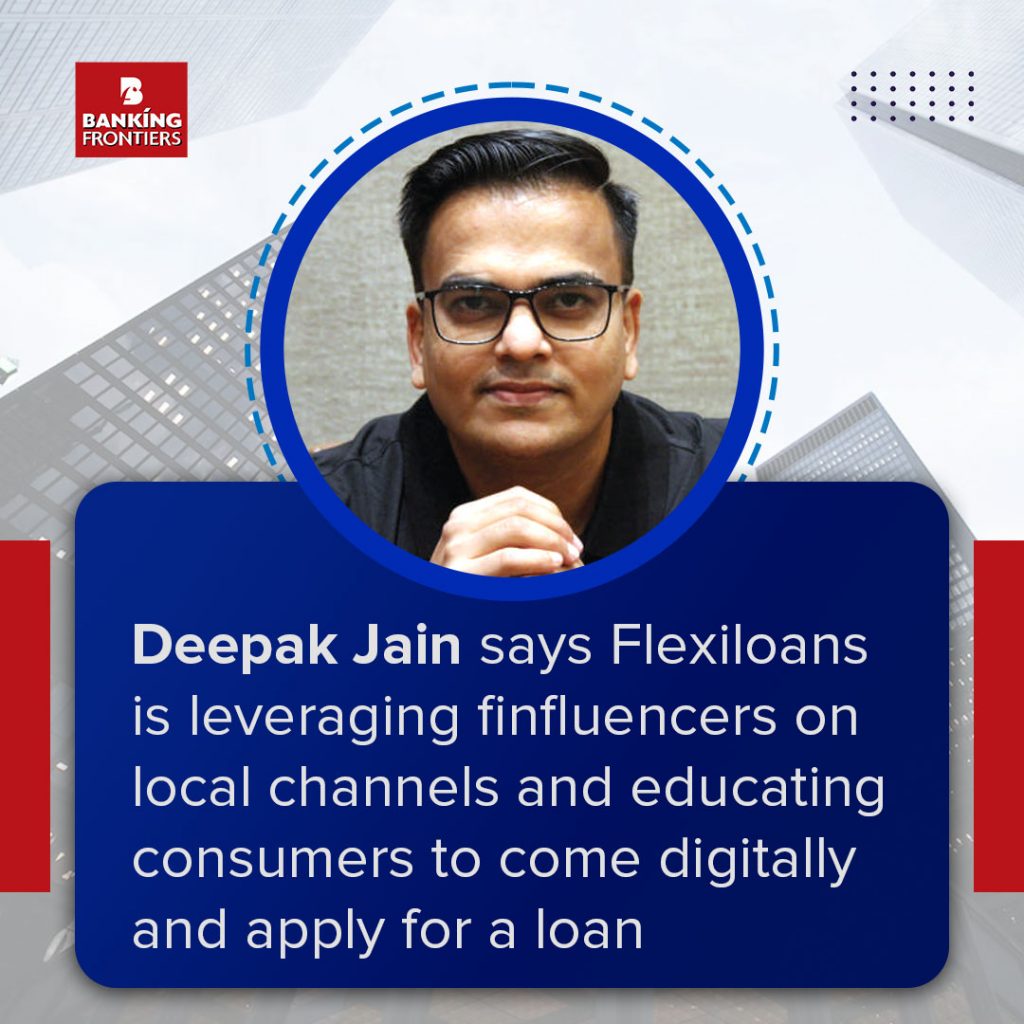 Deepak Jain: Manufacturing in India was very unorganized and there were a large number of manufacturers across the country in sectors like fashion steel, etc. What we are seeing is a lot of B2B players coming in the last 4-5 years and solving for standardization in the supply chains. That’s where a lot of financiers like ourselves have logged on to that phenomenon. There is very high visibility of invoices and movement of goods, and hence financing. At Flexiloans, we have disbursed more than Rs20 billion in last 3 years in SCF, all happening on the back of digitally generated invoices. None of this is this is physical invoices. Once the onboarding of the customer happens, disbursal of loans happens in real time. Also, many brands are coming in in beauty, electronics, sugar, coffee, etc. On the back of that, you’ll see a lot more supply chain standardization happening and therefore supply chain financing as well.
Deepak Jain: Manufacturing in India was very unorganized and there were a large number of manufacturers across the country in sectors like fashion steel, etc. What we are seeing is a lot of B2B players coming in the last 4-5 years and solving for standardization in the supply chains. That’s where a lot of financiers like ourselves have logged on to that phenomenon. There is very high visibility of invoices and movement of goods, and hence financing. At Flexiloans, we have disbursed more than Rs20 billion in last 3 years in SCF, all happening on the back of digitally generated invoices. None of this is this is physical invoices. Once the onboarding of the customer happens, disbursal of loans happens in real time. Also, many brands are coming in in beauty, electronics, sugar, coffee, etc. On the back of that, you’ll see a lot more supply chain standardization happening and therefore supply chain financing as well.
Jugal Mantri: You have raised a very valid and important point that the world is looking outside China and everybody is talking about China +1. So definitely India has a major role to play. We are targeting $5 trillion economy, and currently we are around $3.7 trillion dollars, which means every day we have to add about $2 billion to the economy. So from the global perspective, the sectors which are coming to India span IT, hardware, networking, electronics, etc. Many companies have already announced investments in India and definitely to support them, there’ll be ancillary industries. We NBFC have always looked at the ancillary industry as a sweet spot, and that is where we see the opportunities. We started looking at India as the manufacturing hub for generic medicines and definitely there are opportunities for a lot of suppliers. Similarly for electronics, automobiles, etc. Already there are 5000 ancillary company in Pune which is an auto hub.
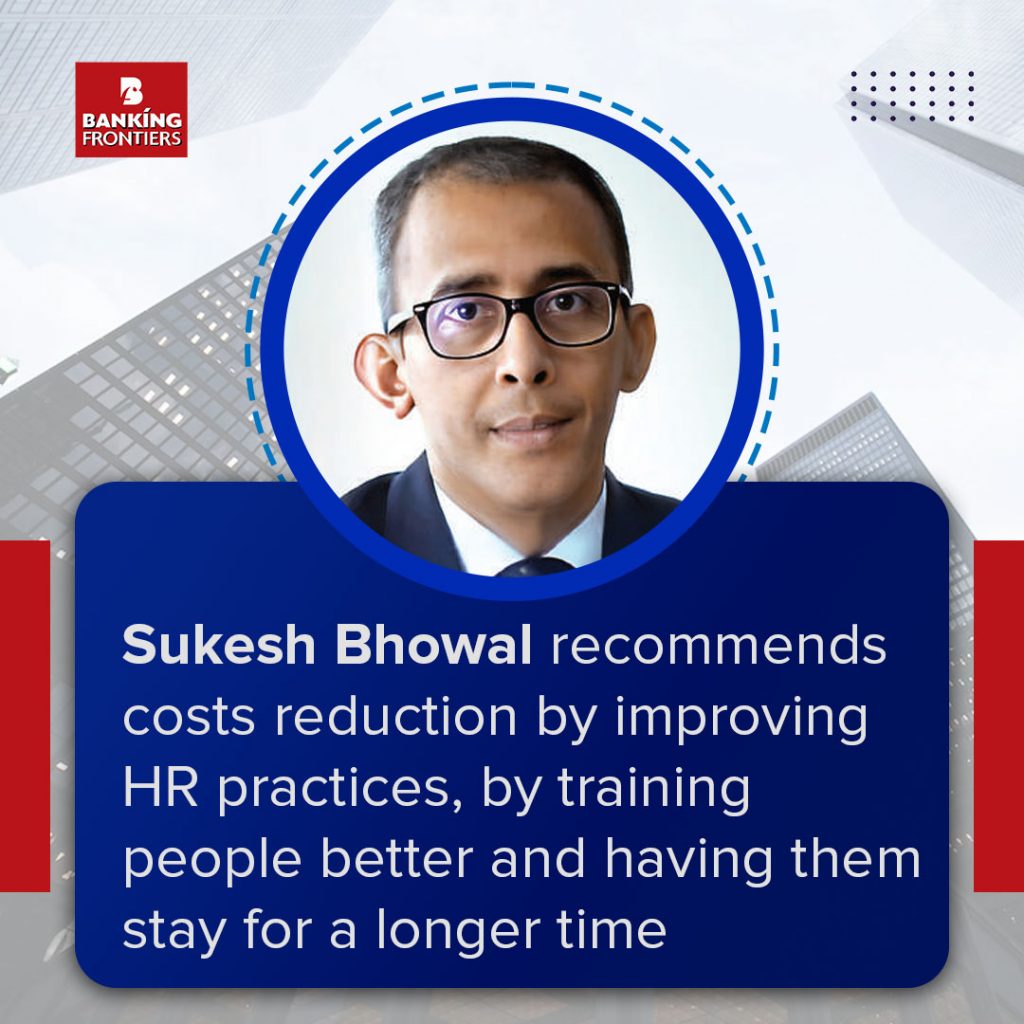 Purvi Bhavsar: Given the kind of geopolitical situation and the climate related events happening across the world, India can play a huge role in food supply chain management, and hence anything to do with agriculture – food processing, warehousing, supply chain management, etc – is going to be a good sector.
Purvi Bhavsar: Given the kind of geopolitical situation and the climate related events happening across the world, India can play a huge role in food supply chain management, and hence anything to do with agriculture – food processing, warehousing, supply chain management, etc – is going to be a good sector.
There are of course many challenges in understanding that sector. Secondly, if I talk about t domestic markets, there is a missing middle which is where microfinance companies have a limitation and banks are not able to reach.
Rakesh Kumar: For any sector, any entity that want to focus must have a deeper understanding of that sector. It must collaborate with relevant stakeholders in the industry like industry association, to understand more details about that sector. In the fast-changing environment, whatever solution is offered must be customized, else you won’t remain relevant, especially when we are talking about global supply chains.
Manoj Agrawal: What do you see as the movement in bringing down the cost of customer acquisition, ie sales and marketing? What works for you – a lot of technology or partnerships or something else?
Sankar Sastri: Cost of customer acquisition is a big topic to consider. Given the kind of lending we do, we are a traditional lender focused on micro-enterprises with an average ticket size of upto Rs5 lakh. We have physical branches and we have employees who acquire customers. That however is not sustainable as we go forward, because with the competition and attrition we have on the front end, its very difficult to maintain the momentum. The potential in this segment is huge, and that’s what is driving growth. There are about 60 million customers in India, so we can easily actually keep thinking next 10 years of growth. What we are trying to do is move away from depending only on physical infrastructure, though our customer segment is not very digital and not many use WhatsApp or smartphones. But they can be digital if we train them and that’s what we are trying to do to be more efficient and more transparent for customers. I can’t say we are fully successful. We are very still piloting, but it will gradually change in the next 5 years.
 Shantanu Rege: I agree entirely with Shankar. We have a Rs70 billion balance sheet, but 11,000 employees. There’s always a lot of advantage to having feet on street but it also adds cost, and the ability of the customers to be able to bear that cost is challenging. Therefore, I think the way to go ahead is to form more partnerships. There are aggregators in the lending space, like DSAs, connectors, even lead-gen partners. There is no point in having 10 feet on street when one entity can aggregate that demand and give it to whichever lender is best suited to serve it. Therefore, we have an immense focus in ensuring that whatever feed on street we have are productive, and if not, actually enable ourselves technologically to be able to serve demand which comes in digitally. This will automatically also lead to a segment of customers who have to be served only physically. We would want to focus on assisted digital or digital-only customers where they can be served digitally.
Shantanu Rege: I agree entirely with Shankar. We have a Rs70 billion balance sheet, but 11,000 employees. There’s always a lot of advantage to having feet on street but it also adds cost, and the ability of the customers to be able to bear that cost is challenging. Therefore, I think the way to go ahead is to form more partnerships. There are aggregators in the lending space, like DSAs, connectors, even lead-gen partners. There is no point in having 10 feet on street when one entity can aggregate that demand and give it to whichever lender is best suited to serve it. Therefore, we have an immense focus in ensuring that whatever feed on street we have are productive, and if not, actually enable ourselves technologically to be able to serve demand which comes in digitally. This will automatically also lead to a segment of customers who have to be served only physically. We would want to focus on assisted digital or digital-only customers where they can be served digitally.
 Deepak Jain: I will add a slightly different perspective. We are a digital only company. We don’t have branches and we don’t have feet on street. We don’t even work with digital aggregators. Yet we are disbursing more than Rs2 billion a month. So how we are doing it? Two channels, one is B2B, where we are the lenders almost all the large ecosystems in the country such as Amazon, Flipkart, etc. Second, we do digital marketing and get almost 500,000 leads on our website every month and that’s a massive channel of growth for us. As more and more lenders are going digital, the costs from Google and Facebook will keep rising. And that’s one area for all of us to watch out for, as those are the dominant players with massive access and reach. So what we are doing is we are leveraging fin-fluencers on local channels and educating consumers to come digitally and apply for a loan. It’s a great source of quality demand. It enables customers to apply for a loan without having to go to a CA or an agent.
Deepak Jain: I will add a slightly different perspective. We are a digital only company. We don’t have branches and we don’t have feet on street. We don’t even work with digital aggregators. Yet we are disbursing more than Rs2 billion a month. So how we are doing it? Two channels, one is B2B, where we are the lenders almost all the large ecosystems in the country such as Amazon, Flipkart, etc. Second, we do digital marketing and get almost 500,000 leads on our website every month and that’s a massive channel of growth for us. As more and more lenders are going digital, the costs from Google and Facebook will keep rising. And that’s one area for all of us to watch out for, as those are the dominant players with massive access and reach. So what we are doing is we are leveraging fin-fluencers on local channels and educating consumers to come digitally and apply for a loan. It’s a great source of quality demand. It enables customers to apply for a loan without having to go to a CA or an agent.
 Vikrant Narang: For any NBFC to to be profitable, it must have a healthy ROI. If you don’t have that or if you don’t have a trajectory towards that, you will not attract capital and you will not be a successful business in the long term. And one of the key ingredients for that is one critical ratio, which is our opex to AUM ratio. As a broad thumb-rule, if this ratio for you is in the high single digits, then obviously you may be in a growth journey or you may be pretty inefficient. I think anywhere between 4 to 5% should be reasonably profitable unless your credit cost is out of control. Second, there is a horses for courses approach. If you are doing secured products, you’re going deeper into the Indian geography, then you must have physical touch. You can use technology, you can automate processes, but it will not do the complete job. So necessarily you will have to have a phygital model, which means that you automate your core but you must have touchpoints for the last mile. As regards unsecured products, our government has done a fab job just in terms of digital KYC infrastructure which gives us the ability to do paperless-less and person-less KYC. Now there are multiple avenues through which you can call data with customer consent, whether it is GST, whether it is banks statements through account aggregator modes and so on. So that’s a different end of the market.
Vikrant Narang: For any NBFC to to be profitable, it must have a healthy ROI. If you don’t have that or if you don’t have a trajectory towards that, you will not attract capital and you will not be a successful business in the long term. And one of the key ingredients for that is one critical ratio, which is our opex to AUM ratio. As a broad thumb-rule, if this ratio for you is in the high single digits, then obviously you may be in a growth journey or you may be pretty inefficient. I think anywhere between 4 to 5% should be reasonably profitable unless your credit cost is out of control. Second, there is a horses for courses approach. If you are doing secured products, you’re going deeper into the Indian geography, then you must have physical touch. You can use technology, you can automate processes, but it will not do the complete job. So necessarily you will have to have a phygital model, which means that you automate your core but you must have touchpoints for the last mile. As regards unsecured products, our government has done a fab job just in terms of digital KYC infrastructure which gives us the ability to do paperless-less and person-less KYC. Now there are multiple avenues through which you can call data with customer consent, whether it is GST, whether it is banks statements through account aggregator modes and so on. So that’s a different end of the market.
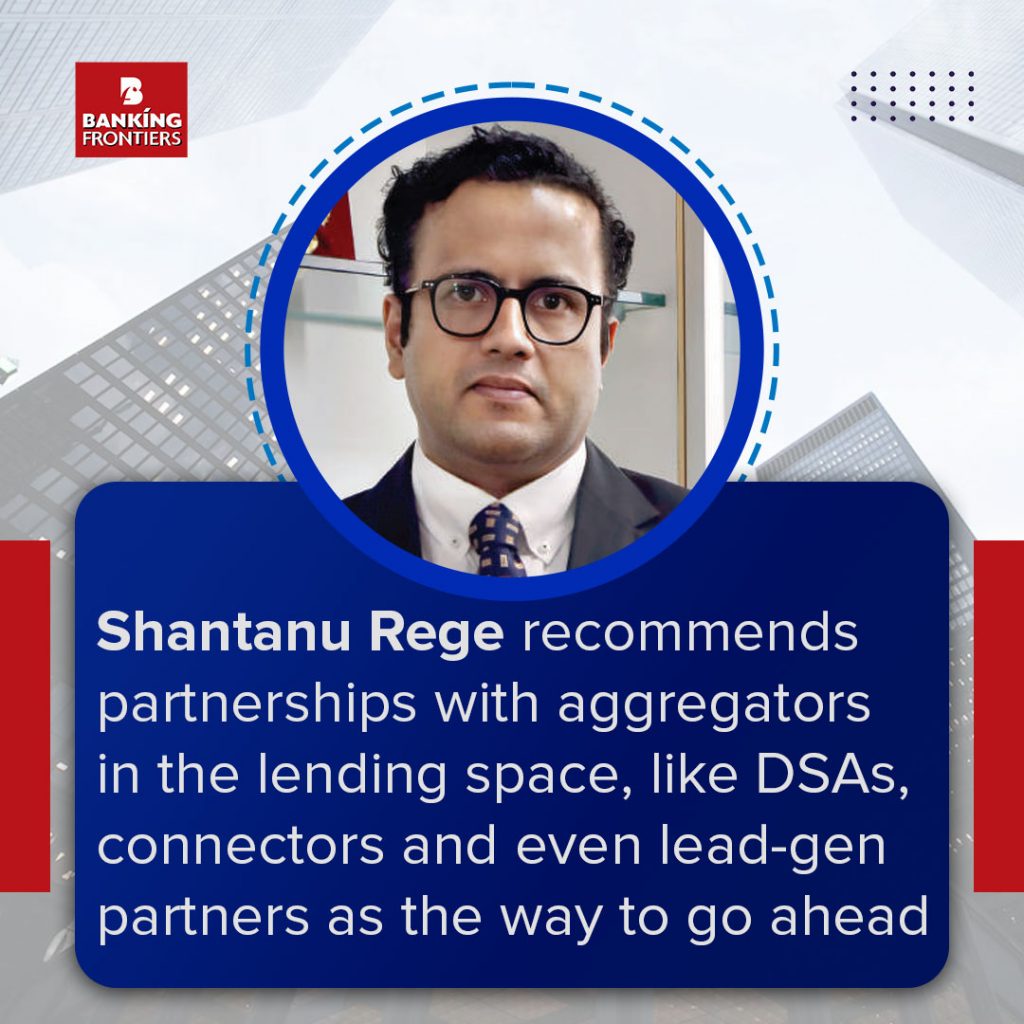 Sukesh Bhowal: Every product will have a different business model and cost model. The cost will vary from 5% to 10%, depending on whether it’s a microfinance product, affordable housing loan, or a prime housing loan. A responsible organization has to work towards reducing the cost – and the ecosystem that the government is building up is do that. As the number of lenders and customers keeps growing, our leading cost is reducing because the number of bank customers is going up and so is our ability to understand them and their repayment behavior. So your rejections come down and the number of customers that you can lend to is moving up. Thanks to UPI, instead of tracking cash flows in a physical manner, you can understand it through the digital footprint. So, a lot of these things are reducing the cost of acquisition.
Sukesh Bhowal: Every product will have a different business model and cost model. The cost will vary from 5% to 10%, depending on whether it’s a microfinance product, affordable housing loan, or a prime housing loan. A responsible organization has to work towards reducing the cost – and the ecosystem that the government is building up is do that. As the number of lenders and customers keeps growing, our leading cost is reducing because the number of bank customers is going up and so is our ability to understand them and their repayment behavior. So your rejections come down and the number of customers that you can lend to is moving up. Thanks to UPI, instead of tracking cash flows in a physical manner, you can understand it through the digital footprint. So, a lot of these things are reducing the cost of acquisition.
 Ultimately you require some people to be there to source customers. There we see a huge amount of attrition because the huge amount of competition is moving people around. That is one key contributors to the cost – some 30,000 people are just coming in, moving in and moving out and they are not productive. They remain for 3-6 months, and then move out. So you can reduce costs by improving your HR practices, by training people better, by having them stay for a longer time. We talk of reducing technology, but a lot of cost can get reduced if you manage people much better.
Ultimately you require some people to be there to source customers. There we see a huge amount of attrition because the huge amount of competition is moving people around. That is one key contributors to the cost – some 30,000 people are just coming in, moving in and moving out and they are not productive. They remain for 3-6 months, and then move out. So you can reduce costs by improving your HR practices, by training people better, by having them stay for a longer time. We talk of reducing technology, but a lot of cost can get reduced if you manage people much better.
 Purvi Bhavsar: I just wanted to add that for the microfinance industry, the cost of customer acquisition is generally very low. But when you talk about the technology, our experience so far has been that in the short to medium term, the cost is going to go up before it goes down, because it is not switching from process A to process B, but rather it is a journey, and hence you are not able to get rid of the older processes, particularly because we deal with a lot of rural customers. So changing is not all that easy. I think it is an 18-24 month cycle where you are able to realize the benefit of the technology that you’re trying to implement.
Purvi Bhavsar: I just wanted to add that for the microfinance industry, the cost of customer acquisition is generally very low. But when you talk about the technology, our experience so far has been that in the short to medium term, the cost is going to go up before it goes down, because it is not switching from process A to process B, but rather it is a journey, and hence you are not able to get rid of the older processes, particularly because we deal with a lot of rural customers. So changing is not all that easy. I think it is an 18-24 month cycle where you are able to realize the benefit of the technology that you’re trying to implement.
Sukesh Bhowal: A question to Shantanu. In the rural areas, given the income to cost ratio and the delinquency rates, does it work out better that in urban areas?
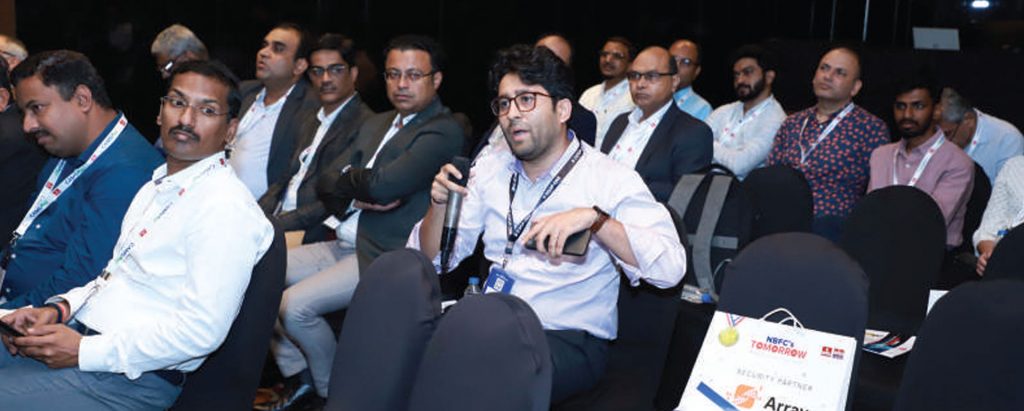 Shantanu Rege: We are one of the few housing finance companies which has a lending rate between 9% and 23%. I think if credit is done well, as you go deeper and as you go smaller ticket size, there are risks and which are more around customers’ ability to pay rather than intent to pay. Rural customers are exposed to vagaries of nature and cash-flow issues which prime customers, such as salaried, are just not exposed to. And I think at 22% it is reasonably priced in if you’ve done your credit well. If you do rural housing very well, it is incredibly profitable, upwards of 5%. That is why a lot of the affordable housing companies are trying to go deeper to include smaller tickets.
Shantanu Rege: We are one of the few housing finance companies which has a lending rate between 9% and 23%. I think if credit is done well, as you go deeper and as you go smaller ticket size, there are risks and which are more around customers’ ability to pay rather than intent to pay. Rural customers are exposed to vagaries of nature and cash-flow issues which prime customers, such as salaried, are just not exposed to. And I think at 22% it is reasonably priced in if you’ve done your credit well. If you do rural housing very well, it is incredibly profitable, upwards of 5%. That is why a lot of the affordable housing companies are trying to go deeper to include smaller tickets.
Manoj Agrawal: Thank you all for an insightful discussion on supply chain financing and customer acquisition costing.
—————————————————————
Part 2
SME Lending – Firing up the Indian Economy
Business leaders from a range of NBFCs dwell on business boosting factors like AI, leveraging alternate data, Co-lending, etc:
Panelists:
- Ameet Venkateshwar, Chief Business Officer, LoanTap
- Navin Saini, Business Head Retail, SME and MSME, Arka Fincap
- Shekaar Subramanian, Head – Structured Finance, Fedbank Financial Services
- Amol Deherkar, Chief Product Officer, NeoGrowth
- Irem Sayeed, Chief Credit Officer, U GRO Capital
- Nitish Maheshwari, Head – Partnerships & Small Business Loans, Incred Finance
- Pankaj Gupta, Chief Business Officer, Godrej Capital
- Moderator: Ravi Virwani, Chief Business Officer, Capital India Home Loans
Ravi Virwani: Are there any live use cases of AI which are being used currently in onboarding or underwriting or something?
Shekaar Subramanian: The DNA of our organization always has been to empower emerging India with easy access to credit. MSME lending is the bulk of our backbone. AI is something that we have always believed to be an enabler rather than a disruptor, which is contrary to the populist thinking. Right from inception, we have been working with tech service providers to help us not only at the back-end, but also the front-end. With their help, we have developed a grading mechanism to ensure that what our feet on street and DSAs are sourcing are screened quickly using AI to grade them as red or amber or green.
 So that saves a lot of time and ensures that a lot of the customers that we want to lend to are not left out. Quick screening enables us to increase the throughput and process files faster. On the back-end, when it comes to the collection, we have done a beta testing to grade our customers and prioritize who is going to repay fast and who’s going to repay for sure. In collections, a lot of time is wasted on figuring out whether customers are going to pay or not. With AI, we focus our efforts 80% on customers less likely and less willing to pay. There’s still a lot of room for improvement.
So that saves a lot of time and ensures that a lot of the customers that we want to lend to are not left out. Quick screening enables us to increase the throughput and process files faster. On the back-end, when it comes to the collection, we have done a beta testing to grade our customers and prioritize who is going to repay fast and who’s going to repay for sure. In collections, a lot of time is wasted on figuring out whether customers are going to pay or not. With AI, we focus our efforts 80% on customers less likely and less willing to pay. There’s still a lot of room for improvement.
 Amol Deherkar: Let’s look back and what has happened in the last 5 years. India Stack is really playing out, and we have account aggregators and GST data. Digital payments have really ramped up over the last 4-5 years. This gives an NBFC or a lender, a rich set of data to work with, which is available for cheap and at a low TAT. It is operationally efficient to get that data and it is less hassle for the customer as well. We have 3 major buckets on how we use this data: (i) customers selection, (ii) portfolio and risk management and (iii) building an objective decision-making framework across various functions in the organization. On the first item, we started our scorecard journey way back in 2018. We started with judgmental scorecards, we saw cycles and that has really accelerated our scorecard journey. Of all the customers that NeoGrowth has scored, 90% of the go /no-go decisions and on exposure are only basis scorecard, and there is no manual intervention.
Amol Deherkar: Let’s look back and what has happened in the last 5 years. India Stack is really playing out, and we have account aggregators and GST data. Digital payments have really ramped up over the last 4-5 years. This gives an NBFC or a lender, a rich set of data to work with, which is available for cheap and at a low TAT. It is operationally efficient to get that data and it is less hassle for the customer as well. We have 3 major buckets on how we use this data: (i) customers selection, (ii) portfolio and risk management and (iii) building an objective decision-making framework across various functions in the organization. On the first item, we started our scorecard journey way back in 2018. We started with judgmental scorecards, we saw cycles and that has really accelerated our scorecard journey. Of all the customers that NeoGrowth has scored, 90% of the go /no-go decisions and on exposure are only basis scorecard, and there is no manual intervention.
 We now have a very modular risk framework. You can choose which risk spectrum you want to work with. Secondly, you can choose the pricing basis the risk riskiness of the customer. The 40 underwriters that we have manage 7000 applications a month, and consequently the sales efficiency is up 2X.
We now have a very modular risk framework. You can choose which risk spectrum you want to work with. Secondly, you can choose the pricing basis the risk riskiness of the customer. The 40 underwriters that we have manage 7000 applications a month, and consequently the sales efficiency is up 2X.
On risk and portfolio management, one interesting use case that we have is our behavioral scorecard on our offers, aggregators, etc. 40% of our customers have given a recurring consent to us and that is really helpful to do the lifetime customer value management. We have an interesting scorecard called Hire Smart, which helps us hire our front-end sales folks. Since this scorecard was implemented, our attrition rate is down by 20%.
Ameet Venkateshwar: We have broken it into 2 parts. First is trying to avoid the friction points in SME lending. It’s not about what I want as a lender, it’s about what is available as an underwriter. If I can bridge this gap, it makes it easier to lend to customers. So one part is the propensity to identify the segment in which I want to lend. The other part is what alternate data is available, and basis that we have designed a score which throws up the risk profile of the customer and helps us decide whether we can go ahead with this loan and at what price. This helps us reduce friction and do faster decisioning.
Navin Saini: While the Indian economy is already fired up, the lending community can only be a catalyst. So to me, AI brings in 2 things very clearly – efficiency and removing biases. For us, 2 use cases have already been powered up. First is how we provide our customers the best fit solution. Most of our lending products and the way they are distributed or marketed, are done through a lot of salespeople and channel partners, and there is a tendency to oversell or overcommit at times. So we have built a bot which will scrape through the entire policy on a real time basis and provide the best fit for the customer to our business manager to pitch to the customer. Eventually our aim is to bring this to the customers on our website and our app, so that customers can choose what is the best fit for them.
 Second, in order to remove bias, the struggle always remains in underwriting is to see how you particularly approach a customer. If your initial impression about a customer is great, your entire tone of questioning and inquiry changes quite a bit. And if you have a very good feel, then you probably will miss out on a few aspects. So here we are using AI wherein based on certain initial information and whatever other data points that we have collected, there is a question bank which comes to the underwriter and basis that he starts deciding as to where the questioning has to go, so that we do not miss out on certain important aspects and do not become biased. So these are two use cases which we have deployed.
Second, in order to remove bias, the struggle always remains in underwriting is to see how you particularly approach a customer. If your initial impression about a customer is great, your entire tone of questioning and inquiry changes quite a bit. And if you have a very good feel, then you probably will miss out on a few aspects. So here we are using AI wherein based on certain initial information and whatever other data points that we have collected, there is a question bank which comes to the underwriter and basis that he starts deciding as to where the questioning has to go, so that we do not miss out on certain important aspects and do not become biased. So these are two use cases which we have deployed.
Ravi Virwani: For a customer for whom sufficient data is not available, how much weightage in your underwriting process giving to alternate data?
 Irem Sayeed: We don’t call ourselves a fintech company, we still are a fintouch company and that touch part is going and meeting the customer and looking at things like who’s there in the family, where is the business operating from, what kind of workplace it is, etc. We also look at compliances such as whether the company is making EPF and GST payments on time. We are very ESG conscious as well, so we see how many female employees are there and whether there are the appropriate amenities for them in the premises. These things do contribute to the longevity of the business. So these often aspects are important and if they are missing, we probably will not select the customer for lending. So yes, we use a lot of such alternate data.
Irem Sayeed: We don’t call ourselves a fintech company, we still are a fintouch company and that touch part is going and meeting the customer and looking at things like who’s there in the family, where is the business operating from, what kind of workplace it is, etc. We also look at compliances such as whether the company is making EPF and GST payments on time. We are very ESG conscious as well, so we see how many female employees are there and whether there are the appropriate amenities for them in the premises. These things do contribute to the longevity of the business. So these often aspects are important and if they are missing, we probably will not select the customer for lending. So yes, we use a lot of such alternate data.
Nitish Maheshwari: We use a lot of AI and alternate data. We don’t source a single loan from a DSA; 100% of our sourcing is actually driven with AI and alternate data. We work with a lot of e-com players, aggregators, marketplaces, restaurant aggregators, payment gateways, logistic partners, etc. From an underwriting and sourcing perspective, it is, it is largely data driven in terms of the transactional data, in terms of the vintage on a particular platform. Their ratings and reviews are fairly important, but not for making a lending decision, but it helps as we capture ratings on a monthly basis. We also look at the percentage of customers who give ratings. We’ve created a very good blend of subjective decision making for some of the sales managers and the frontline staff. Our underwriting is largely AI driven.
Ravi Virwani: How are lenders helping SMEs beyond providing credit?
 Pankaj Gupta: Godrej is in the business for the last 125 years. So when we when we started carving out our purpose of building business, we said we want to build 2 large businesses in India – consumer finance and MSME finance. Now, since we are having multiple companies in business for ages, our thought process is that we must understand MSMEs and their challenges in detail, because we deal as a group with a lot of companies and supply chain ecosystems and MSMEs. We understand that they don’t have access to not only just credit. So being an NBFC and giving a loan is very easy. We could have simply taken that path. I am not sure that how many companies in India will take this initiative of helping MSME with an initiative like Nirman where there is cost involved beyond lending. This includes our tie-up with Amazon, legal help and consultancy for free.
Pankaj Gupta: Godrej is in the business for the last 125 years. So when we when we started carving out our purpose of building business, we said we want to build 2 large businesses in India – consumer finance and MSME finance. Now, since we are having multiple companies in business for ages, our thought process is that we must understand MSMEs and their challenges in detail, because we deal as a group with a lot of companies and supply chain ecosystems and MSMEs. We understand that they don’t have access to not only just credit. So being an NBFC and giving a loan is very easy. We could have simply taken that path. I am not sure that how many companies in India will take this initiative of helping MSME with an initiative like Nirman where there is cost involved beyond lending. This includes our tie-up with Amazon, legal help and consultancy for free.
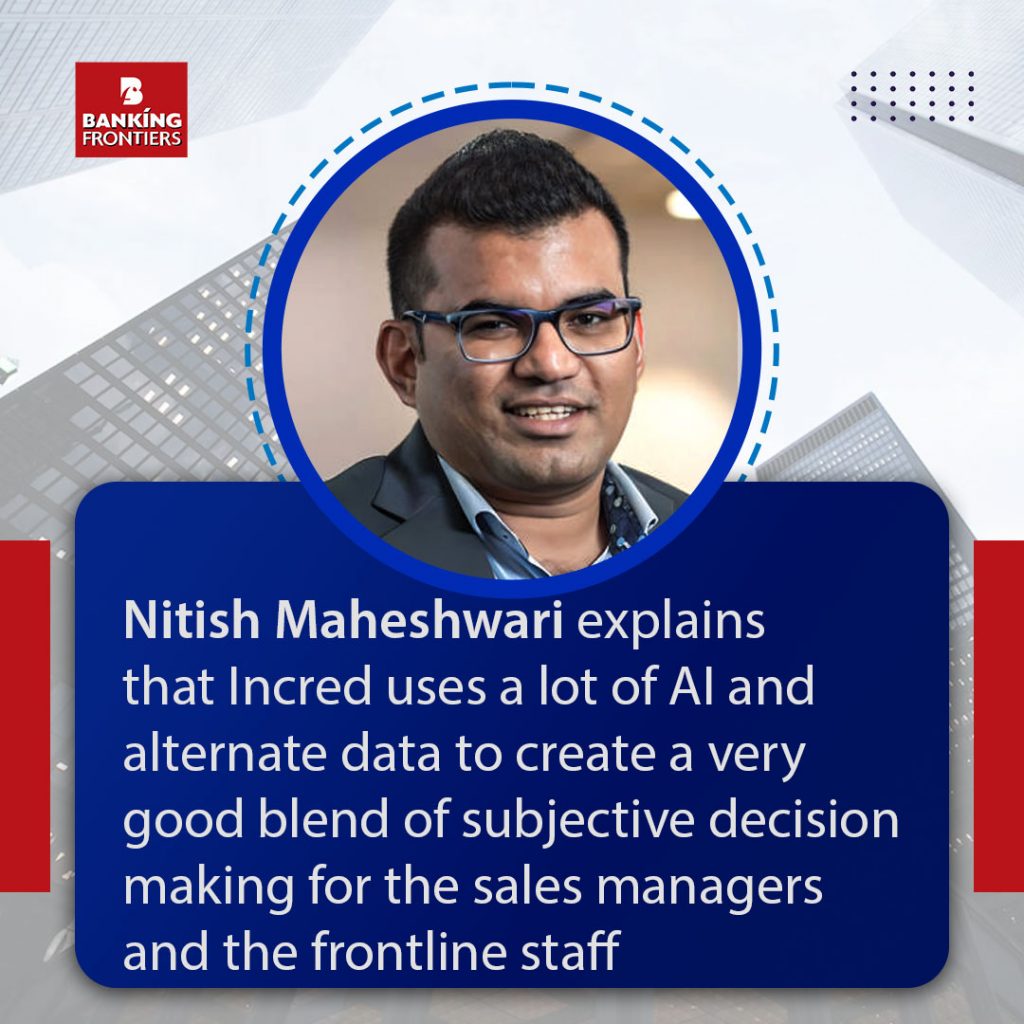 Our thought process is we want to be in the business for next few decades, helping MSMEs with their overall needs, including their people needs and services and the tie-ups. We have as a group have the ability to negotiate with large partners like Amazon on behalf of MSMEs and then provide them access through that platform. This has benefited a few thousand customers.
Our thought process is we want to be in the business for next few decades, helping MSMEs with their overall needs, including their people needs and services and the tie-ups. We have as a group have the ability to negotiate with large partners like Amazon on behalf of MSMEs and then provide them access through that platform. This has benefited a few thousand customers.
Amol Deherkar: There are 150,000 users on our DigiBiz platform. When everyone was busy collecting money. we reached out to these customers to ask what is bothering them. And one of the things that they said is that as the world looks more digital, how will they compete, especially with the e-comm giants. That is when we said that everyone wants to digitize and they didn’t know how and that was the genesis of how DigiBiz came in to being. Basically we gave them a tool to assess where they are in their digital journey. The report shows them where they are currently and offers a roadmap and who they can work with to complete the journey.
Another initiative that we have is a platform for new insight. With our understanding of this ecosystem, we try to create studies and reports and propagate them so that the ecosystem understands what they really need. Also, everyone sells insurance to their customers, but we provide it free of cost. 100% of our customers get a free insurance when we give them a loan. It protects them in a downturn, and it helps them manage the volatility better. So these are some of the non-credit things we do.
Ravi Virwani: Has co-lending with banks really picked up for SME sector?
 Shekaar Subramanian: Yes, banks have been warming up to the idea of co-lending, which was not the case 10-15 years ago. Banks were shy in lending to new-to-credit customers for obvious reasons. So they needed a partner and that’s where NBFCs and fintech had a big role to play, and they continue to do so. For us, it helped us increase the pie and also enable us to expand geographically. Banks want to understand those customers so that that one day they can serve them the way they would want to. It is taking time as banks warm up to the idea of co-lending because there has to be some synergy between products from banks and NBFCs. Today, we have a tie-up with 2-3 PSU banks and it stands at around 10-15% of our book.
Shekaar Subramanian: Yes, banks have been warming up to the idea of co-lending, which was not the case 10-15 years ago. Banks were shy in lending to new-to-credit customers for obvious reasons. So they needed a partner and that’s where NBFCs and fintech had a big role to play, and they continue to do so. For us, it helped us increase the pie and also enable us to expand geographically. Banks want to understand those customers so that that one day they can serve them the way they would want to. It is taking time as banks warm up to the idea of co-lending because there has to be some synergy between products from banks and NBFCs. Today, we have a tie-up with 2-3 PSU banks and it stands at around 10-15% of our book.
Irem Sayeed: Co-lending is one of the success stories for us. When we started in 2021, every file was in physical form and every document required my physical signature. From there, we have now come to being fully integrated with banks and now within 24 hours we get the decision from the banks. So things have really changed, and banks are keen to acquire customers. Overall 40% of our AUM is either co-lent or co- originated.
Ravi Virwani: Thank you all panelists.
————————————————————-
Part 3:
Analytics: Leveraging Alternate Data;
Driving Revenue Growth
Panelists from a range of NBFC describe various use cases for alternate data and how analytics is driving revenue growth:
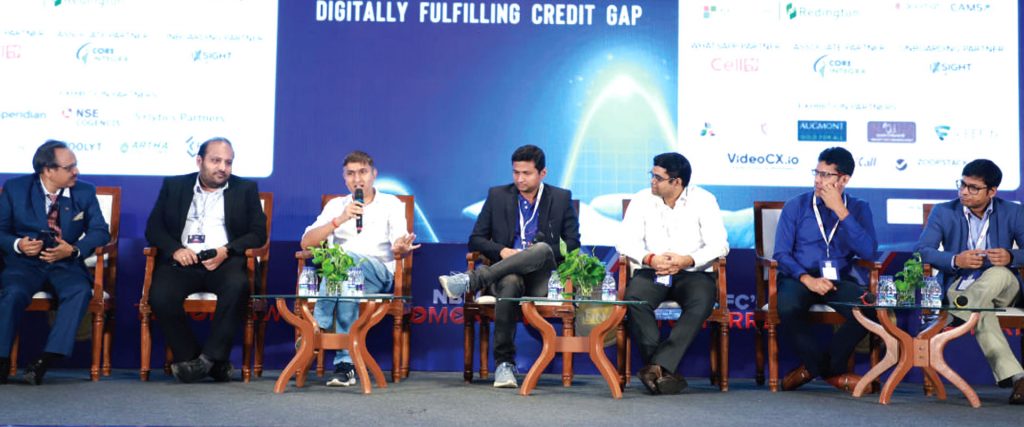
Panelists:
- Markandey Upadhyay, Chief Data & Analytics Officer, Piramal Capital & Housing Finance
- Mohan Sushantam, Chief Data Officer, Vivriti Capital
- Virendra Pal, Chief Data Science Officer, LenDenClub
- Subrata Das, Chief Innovation Officer, U GRO Capital
- Arihant Jain, Head of Data Science, Analytics & Product, IIFL Finance
- Ratul Paul, Chief Data Officer, Ecofy
- Moderator: Manoj Agrawal, Group Editor, Banking Frontiers
Manoj Agrawal: Analytics is not something new. It has been analyzing traditional data, whether it’s financial data or employment data or business data. But in the digital world, we have a whole lot of alternate data such as browsing behavior, where are you clicking, where are you spending time, where you are shopping, etc. Lots of companies like Amazon and Netflix are mining this non-traditional data and making gold out of it. So, what are the challenges and opportunities for NBFCs in analyzing such data?
 Ratul Paul: I had an opportunity to work with SMS and cookie data. These are unstructured data. SMS data can be a good proxy to bank statement because at least in India, we get an SMS notification every time there is a debit or credit, and you also get account balances by SMS. You can literally build a proxy bank statement with SMS data and also get to know spending patterns, salary, credit, EMI, etc. So, the lender doesn’t have to ask the customer for a bank statement. As soon as the customer downloads my app, if I can get the data, then I can process it in seconds, generate a proxy bank statement and determine loan eligibility.
Ratul Paul: I had an opportunity to work with SMS and cookie data. These are unstructured data. SMS data can be a good proxy to bank statement because at least in India, we get an SMS notification every time there is a debit or credit, and you also get account balances by SMS. You can literally build a proxy bank statement with SMS data and also get to know spending patterns, salary, credit, EMI, etc. So, the lender doesn’t have to ask the customer for a bank statement. As soon as the customer downloads my app, if I can get the data, then I can process it in seconds, generate a proxy bank statement and determine loan eligibility.
 Virendra Pal: There are various types of alternate data. But we also have to figure it out feasibility. For example, if you are going for Rs5000 loan, you cannot go ahead with all sort of alternate data as it will not be feasible. So, it is very important to know that kind of pattern and behavior you want to capture. For example, people who are playing much more intelligent games and that sort of information is coming from their apps. However, all these things are very subjective, and also there is a cost associated with sourcing, churning, processing, and that cost determines loan ticket size.
Virendra Pal: There are various types of alternate data. But we also have to figure it out feasibility. For example, if you are going for Rs5000 loan, you cannot go ahead with all sort of alternate data as it will not be feasible. So, it is very important to know that kind of pattern and behavior you want to capture. For example, people who are playing much more intelligent games and that sort of information is coming from their apps. However, all these things are very subjective, and also there is a cost associated with sourcing, churning, processing, and that cost determines loan ticket size.
Markandey Upadhyay: Few things are important. First is acquiring the data legitimately within the legal framework. One must know the framework through which the data is being acquired. Second, analytics is generally a very central office oriented function in the sense people make very fancy PowerPoint presentations with a lot of good insights. However, unless that analytics gets packaged into some API and get consumed into some decision-making process and get used widely, it won’t give an ROI. Third point is that alternate data is not establish data like account balance, which has been established for 20 years. Alternate data is very new data, and you cannot jump into investing and consuming it. You have to see how it aligns with target variables. The alternate data may change and what was effective yesterday may no longer be effective today. For example, customers buying on one portal may have a different profile from those buying on another portal, and this may keep changing.
So, it requires a lot of hard work and investment. The broader point is that analytics is a very useful tool, but you must have a very strong framework of what data you use and how you use it. Apart from a good analytics person, you must have a really good tech person because if you cannot put your analytics into an API, then it cannot be consumed, and it will not be useful.

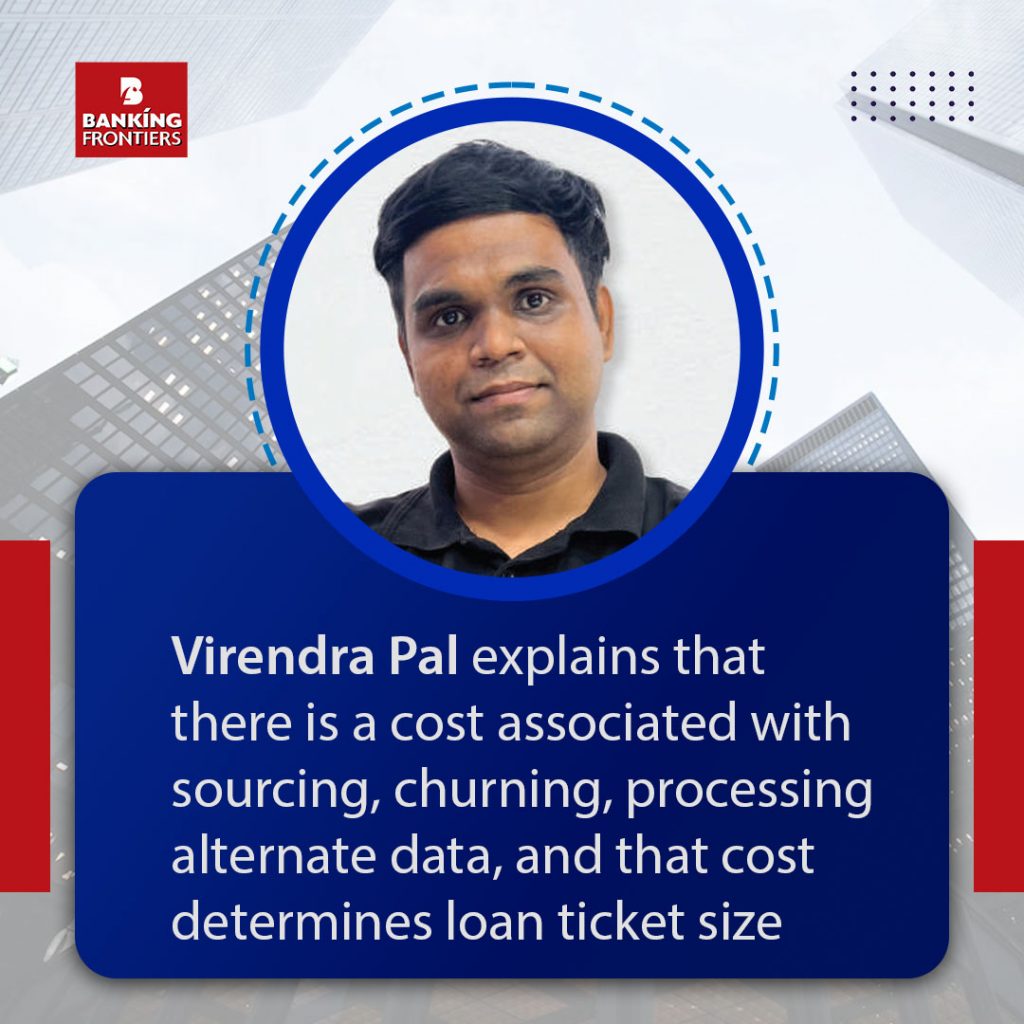 Arihant Jain: What is most important for any NBFC in this space is underwriting, and then other verticals come in such as collections, marketing, etc. And the fundamental of risk underwriting for an NBFCs is intent to pay and ability to pay. Now, alternate data, whether it is SMS data or digital footprint of customer or social media, all this is helpful if taken in context. The new angle which is evolving now is persona-based underwriting, and here all data points come into the picture and not only from a risk point of view, but also from a marketing point of view. For example, let’s say there is a customer who has a very influential profile comes on your platform for taking a loan. If you know that that guy is an influencer on social media or let’s say that guy is from a premium category, the documents that you are asking for, you have to minimize it. So, you have to personalize the digital journey as per the persona of the customer. To enable this, you need a lot of tech, a lot of infra, a good tech team and a good cloud system.
Arihant Jain: What is most important for any NBFC in this space is underwriting, and then other verticals come in such as collections, marketing, etc. And the fundamental of risk underwriting for an NBFCs is intent to pay and ability to pay. Now, alternate data, whether it is SMS data or digital footprint of customer or social media, all this is helpful if taken in context. The new angle which is evolving now is persona-based underwriting, and here all data points come into the picture and not only from a risk point of view, but also from a marketing point of view. For example, let’s say there is a customer who has a very influential profile comes on your platform for taking a loan. If you know that that guy is an influencer on social media or let’s say that guy is from a premium category, the documents that you are asking for, you have to minimize it. So, you have to personalize the digital journey as per the persona of the customer. To enable this, you need a lot of tech, a lot of infra, a good tech team and a good cloud system.
 Subrata Das: SME lending in India is considered to be highly physical because of the heterogeneity and the tremendous amount of nuances. Here too we have seen so much advancement with alternate data. 5-10 years ago, we were talking about converting a process to a digital process or reducing the use of people. But fast forward to today, we are seeing how to create sophisticated decisions and enhancing the quality of decisions, not just reducing people involvement. So how to measure the ROI is so important today and is well facilitated because today’s operations are technology driven journeys and workflows. For example, if somebody has to reduce TAT, that is measurable, if somebody has to increase collections, that’s measurable, if somebody has to improve approval rates of his loan business, that is measurable. And I think the fact that the process allows these metrics to be measured is one of the main points which will drive ROI in the automation.
Subrata Das: SME lending in India is considered to be highly physical because of the heterogeneity and the tremendous amount of nuances. Here too we have seen so much advancement with alternate data. 5-10 years ago, we were talking about converting a process to a digital process or reducing the use of people. But fast forward to today, we are seeing how to create sophisticated decisions and enhancing the quality of decisions, not just reducing people involvement. So how to measure the ROI is so important today and is well facilitated because today’s operations are technology driven journeys and workflows. For example, if somebody has to reduce TAT, that is measurable, if somebody has to increase collections, that’s measurable, if somebody has to improve approval rates of his loan business, that is measurable. And I think the fact that the process allows these metrics to be measured is one of the main points which will drive ROI in the automation.
Mohan Sushantam: From an ROI perspective, I will share a discussion I had with my MD & CEO. When I was talking to him about my KRAs, the issue that arose was how to measure the efficiency of the data analyst – by the number of models they build, by the number of dashboards they delivered, the kind of data activities they did, etc. No. Efficiency or proactivity has to be measured in terms of business outcomes. And then we started deciding on what kind of business outcomes a team can drive. And that is very simple – the business outcome is to drive the topline and bottomline. So that boils down to retaining existing good customers, turning away the bad customers, get better good customers – all that leads to organic growth. So that’s how the data teams are measured. So, every data activity – be it a plain vanilla dashboard or building a propensity model or building a credit risk model or A/B testing – it all has to relate to topline and bottomline. For us at Vivriti Capital, we are into B2B lending and we haven’t found a lot of value in alternate data because a lot of unexplored, structured data is available in the market.
Markandey Upadhyay: I don’t think the question is whether alternative data is helpful or not. The question is when is that data helpful. If I have a bureau data, bank statement data, GST data, account aggregator data, etc, do I really need to go and get alternate data. No. But if data is missing or the ticket size does not allow you to ask for bank statement, then alternate data is helpful.
Manoj: Another business objective for NBFCs is definitely growth. This is a sector like fintechs – if you don’t grow, you may die. So how do you see analytics empowering growth?
Mohan Sushantam: So Vivitri Capital is an NBFC which lends to corporates. We have identified our total available market size in India at close to 15,000 companies. And we have relationship managers whose job is to be on the road, meet these companies, identify opportunities, and then figure out what kind of product we can pitch to them so that become our customer and we grow our topline. Our relationship managers do a lot of research before they reach out to the right prospects with suitable products. Typically, a sales team will be most productive if they have everything available to them at their fingertips and they are on the road.
How can the data team enable that – by automating a lot of things that they do manually including data entry, data analysis, creating charts, generating insights, etc. They also do a lot of research on Google and different websites. Can the entire process be automated? Yes. So, when they punch in the company name, they get a 360-degree view of the company covering sector, ratings, revenue, cash flow, sector performance, etc. So, what they have to do is use this information and go and meet the customers. So initially, if they were meeting 2 prospects every day because they were spending most of their time sitting in office and doing all that research, now because analytics enables them, then can meet 7-8 prospects in a day. And that boosts revenue and topline.
 Ratul Paul: I want to talk about a simple machine learning use case on top of it where, by looking at historical data of who converted and who did not convert, we built a simple machine learning algorithm. Say one third actually convert and gives say 90% of the revenue, then we can optimize the sales meetings and business plan accordingly.
Ratul Paul: I want to talk about a simple machine learning use case on top of it where, by looking at historical data of who converted and who did not convert, we built a simple machine learning algorithm. Say one third actually convert and gives say 90% of the revenue, then we can optimize the sales meetings and business plan accordingly.
Virendra Pal: Growth can be derived at any stage of loan lifecycle. Since we are fully digital, the way we are targeting our customer, it has to be very precise. If suppose I’m targeting wrong customer age group or income group, then our funnel will not increase. Eventually marketing costs are always going to keep rising, but if you rightly target and personalize your campaign, you will get funnel growth. At the underwriting stage, suppose you got all the data, but eventually after disbursing loan you figure out that person is not contactable for the first payment, then it’s a problem. Can this be done at the underwriting stage? If one can do that, then profits will rise.
Eventually there is also a need to create the right products. If an NBFC is targeting salaried people, what about those people who are self-employed? Can we create a product or model that we can lend to them – this will generate additional sales and revenue.
Arihant Jain: One of the use cases for growth side is to leverage fintech companies who are providing area-wise insight such as number of shopkeepers, societies, malls, etc. These data points can help identify the emerging areas for targeting via Facebook, Google, etc. You can even see from which areas more enquiries are coming for personal loans, home loans, etc. If you have a physical setup, you can give this data to your sales team, and if you are doing digital marketing, you can give it to your performance marketing and social media teams. Similarly, you can identify areas where there are different kinds of frauds happening and plan accordingly.
Subrata Das: I would look at growth analytics in broadly in 3 buckets. The first bucket is analysis of the target market, ie the geography. This is particularly relevant for distribution channels which are focused on catchments. So the questions to ask are: is this place right to open a branch? Is it rich in business opportunity 100-kilometer radius? If so, then what are the ways to take the branches to break even and then to be profitability. The second part is the customer centric analytics of the needs of the customer. The third part of the growth analytics is focused on the efficiency and productivity of the workforce. It can be productivity of the distribution workforce or the credit assessment workforce from a lending standpoint – and targeted and optimizing those metrics. From an organizational standpoint, when we are trying to use analytics to drive growth, we are basically trying to identify the right strings to pull in any of those buckets.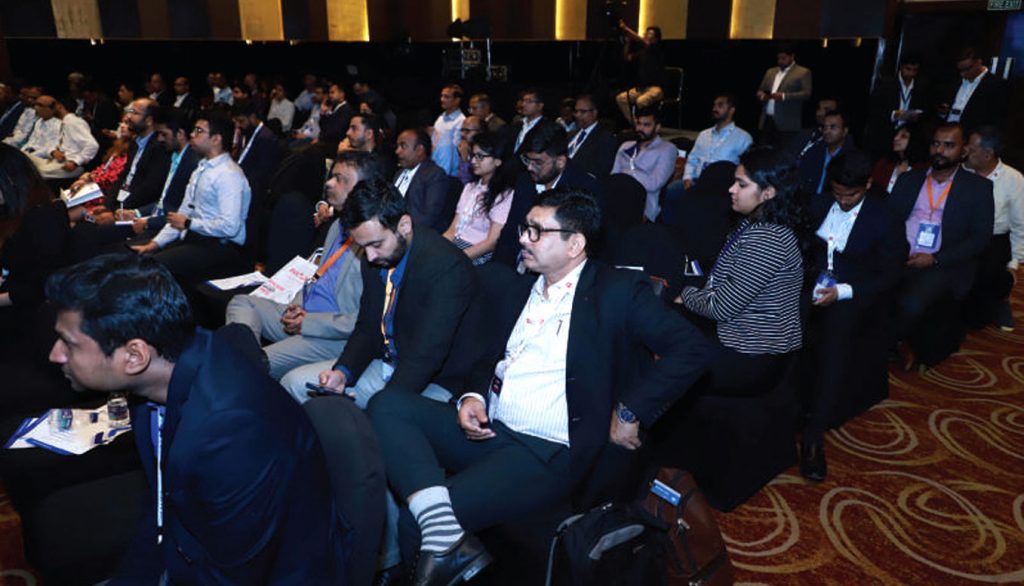
Manoj Agrawal: Thank you, panelists, for a variety of fresh perspectives on analytics.
Read more:
Aviva: Customer bot usage rises to 25-30%





